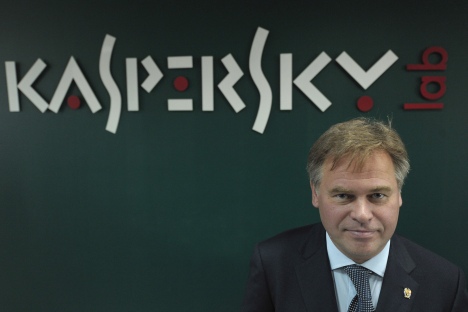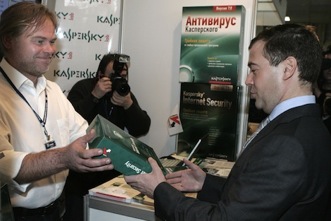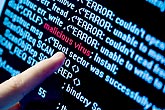Russian antivirus providers gearing to cure Indian IT

In Russia Kaspersky secures 52.7 percent market share followed by ESET with about 27 percent of the market. Source: Sergey Guneev/RIA Novosti
Russian antivirus vendors entered the Indian market quite late compared to global industry leaders that have a presence in India for the past 10-15 years. That did not prevent some of them from gaining leading positions though. Recently Kaspersky Lab, the leader of the Russian antivirus market announced its plans to increase its market share up to 25 percent from the current 15 percent in India.
“Traditionally, our growth has been a result of our strong channel network. In the last three years we have consolidated our channel presence and we are further increasing our reach in tier 2 and tier 3 cities,” says Maxim Mitrokhin, Director of Operations, Kaspersky Lab, Asia-Pacific. “During this period, we have also invested heavily in building the brand through effective marketing campaigns and consistent PR efforts.”
Kaspersky started operations in India in 2010 with Hyderabad-based Zoom Technologies as a national distributor. The company then was reported to invest $2 million within the first year of operations. Later Kaspersky appointed another national distributor, Pune-based SAKRI IT Solutions that carried all major marketing and sales activities in the consumer segment. In 2012, Kaspersky Lab expanded its direct presence in India shifting main operations to a new Mumbai office.
Kaspersky’s late arrival to India was made up by huge spending on marketing and advertising. Having had actor Jackie Chan as its global brand ambassador since 2009, Kaspersky went even further in India signing up with Indian cricket idol Sachin Tendulkar. “Cricket is religion in India. The youth of this nation look up to Sachin Tendulkar as a huge inspiration. We are naturally excited to be associated with the cricketing maestro,” Maxim Mitrokhin says.
The deal with India’s cricketing legend could cost the company tens of millions dollars while company’s earnings in India stood at about $8-10 million in 2012 with $6.7 million in the consumer segment, according to Gartner. Kaspersky Lab said its global turnover topped $612 million in 2011.
Family traditions
The potential of the growing IT security industry, especially in small and medium enterprise segments attracted another security company associated with the Kaspersky brand, EgoSecure. The company is led by the ex-wife of Eugene Kaspersky, Natalya Kaspersky, who was a co-founder of the Kaspersky lab and its chairperson till 2011 when the couple finally split.
Natalya took over InfoWatch, a subsidiary of Kaspersky lab formed in 2003 that specialises in enterprise DLP (Data Loss Protection) solutions. In 2012 InfoWatch separated from Kaspersky Lab while the former bought back all the shares in the company belonging to Natalya Kaspersky. In 2011, InfoWatch acquired Cynapspro GmbH, a German company specialising in enterprise endpoint protection. The company was then transformed into EgoSecure. Later Mrs. Kaspersky invested in another German company, antivirus provider G Data, acquiring a 16.3 percent stake in it in 2012.
Natalya Kaspersky seems to recognize the potential of Indian market. Recently her EgoSecure launched its India operations the same way as three years back Kaspersky Lab did: appointing the same Zoom Technologies from Hyderabad as its distributor. EgoSecure announced investing around $1 million in setting up an R&D facility next year. The company is eyeing a 10-15 percent share of endpoint security market targeting mostly banks, government agencies and the corporate sector.
Despite difficulties
Among later comers to Indian antivirus market is Dr. Web, one of the pioneers of Russian antivirus industry. Dr. Web started operations in India in January 2013 thorough Chennai-based Netflix Technologies formed by prominent industry players experienced in antivirus distribution.
“The number of internet users in India grows every year so quality antivirus products are in demand. Initially we entered Indian market with our consumer retail products through our main focus is enterprise segment,” Eugenia Hamrakulova, the head of international partner relations department at Dr. Web in Moscow told RIR.
It is quite difficult to define the price for retail consumer products in India, she adds. The Indian market is not only price-sensitive but quite uncontrollable in terms of price formation. While every product has its MRP (maximum retail price), dealers and resellers purchasing from larger distributors at discounted prices can set up their own price for the end-user. It may become even 50 percent less than MRP. Being at the very top of distribution channel antivirus vendors have little control over it.
The pricing in India and Russia as well as the rest of the world varies at times. For example, a plain antivirus product of any of the leading brands for 1 PC per year in Russia will cost somewhere in the range of $35-40 while in India the same product will have a MRP of $8-10 and the actual market price as low as $4-5.
Government regulations are also an issue for both foreign and local industry players. “The antivirus industry suffers from tangled taxation policies, it is not yet clear if software should be treated as goods or service and thus how it should be taxed so every year software companies struggle with new tax charges. Since last year all major antivirus companies have to face this problem,” says Pankaj Jain, Director at ESS Distribution, which distributes ESET products in India.
Originally from Slovakia, ESET today is the second largest player in Russia & CIS after Kaspersky. It also started active operation in India from 2009-2010. By this time ESET could gain around 5 percent market share, according to company’s estimation.
Competition for security
There are about 30 antivirus brands in India half of which are very active in the market. There are global leaders in free segment AVG and Avira, Microsoft Essentials, paid antivirus providers such as Symantec, McAfee, TrendMicro, Kaspersky, ESET, Bitdefender, Panda Security and local players Quick Heal, K7 eScan, Netprotector among others.
In 2011 Gartner estimated the Indian IT security market at around $218 million with an annual growth rate of around 20 percent, however, in 2012 the market growth decreased to 10-12 percent due to overall economic slowdown along with weak rupee. In 2012 the market rose to about $240 million with consumer segment accounting for $61,7 million, according to Gartner. The industry players estimate consumer segment value in the range of $110-$160 million.
By comparison, the value of the Russian antivirus market is just a bit higher, around $300-334 million in 2011-2012, according to various analysts. However, the number of internet users in Russia is 50 million (43 percent of adult population) while in India with its 1.2 billion population the number of Internet users does not exceed 120-160 million people.
“Considering the population and emerging of new platforms the Indian market has a lot of potential for both existing players and even new comers,” Aheesh Raina, principal research analyst at Gartner India believes.
In Russia Kaspersky secures 52.7 percent market share followed by ESET with about 27 percent of the market. Dr. Web enjoys only 6.7 percent of the market share while global leaders Symantec, Trend Micro and McAfee have even less than that.
The scenario is different in India. According to Gartner, Symantec is leading with 48.7 percent share, followed by Quick Heal, a Pune-based company with almost $35 million in turnover in 2012. In the enterprise segment, their positions shift: Quick Heal leads with 29.6 percent share and Symantec follows it closely. Kaspersky has 11 percent in the consumer segment and 9.4 percent in the enterprise segment, according to Gartner.
Industry players, however, have a completely different picture of the market putting QuickHeal and Kaspersky at the leading positions in the consumer segment followed by Symantec while in the enterprise segment Symantec is leading followed by TrendMicro and McAfee. The difference lies in the way of segmenting the market and estimating vendors’ and distributors’ revenues, experts say.
One more peculiarity of Indian antivirus market is the phenomena of small scale local brands manufactured and sold at IT & software hubs like Nehru-place in Delhi and Lamington road in Mumbai. Some of them, like Netprotector or NPAV antivirus could even become top-selling products in the retail consumer segment. While market leaders QuickHeal and Kaspersky were selling about 100,000 retail boxes per month in 2012, Netprotector was selling close to 80,000 boxes, industry players say. The success of the company that does not have any R&D or virus lab or even its own scanning engine, the very heart of good antivirus product, puzzles many industry leaders.
Eugenia Hamrakulova of Dr. Web says the company gets many requests for licensing its technology, i.e. using Dr. Web’s genuine scanning engine or any other software module to create new antivirus brand. “We are considering several such projects currently,” Hamrakulova said.
Antivirus brand PremiumAV sold in Delhi for USD $3.5 per license claims the software had been developed in Russia. However no one in the company’s office at Nehru place could elaborate on connection with Russia. Perhaps, it is the reputation of Russia as a country hosting the smartest hackers and cybercriminals that brings Russian antivirus providers fame as well.
All rights reserved by Rossiyskaya Gazeta.
Subscribe
to our newsletter!
Get the week's best stories straight to your inbox


